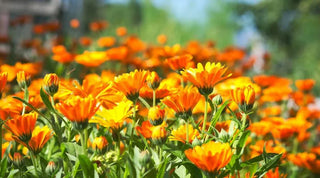Calendula, also known as pot marigold, was one of Thomas Jefferson's favorite flowers. Maybe he enjoyed the fact that the flowers are edible as well as pretty, adding zing to salads and stir fries.
Calendula is an easy to sow and grow annual that is almost foolproof. Instead of purchasing a 6-pack of calendula plants at your local nursery, consider buying a packet of seeds. During the first several weeks of the growing season, you can tuck the seeds here and there, wherever there's a free space. The plants grow quickly and will start blooming just a couple weeks later than the transplants. Most people find calendula plants that are started right in the garden outperform purchased plants perhaps because the plants resent being moved and having their roots disturbed.

Calendula seeds are shaped like little scimitars and are large enough that you or your children can handle them easily. The seeds can be planted at any time in the spring. The seeds will decide when it's time to start growing. Cover them with about a quarter inch of soil, press down gently with your fingers, and water thoroughly.
Modern plant breeders have developed lots of calendula varieties: some single-petaled, some doubles, some semi-doubles. Besides the standard egg yolk yellow ones you can now grow calendula that are orange, maroon, cream and some that are almost pink.
To keep your calendula plants blooming as long as possible, nip off the spent blooms before the seeds can form. If your plants do produce some seeds in late summer, let them fall to the ground and you'll probably get some effort-free "volunteers" next spring.
Add a pinch or two of calendula petals (not the tough green base of the flower) to tossed salads and stir fries. Use them to garnish potato salads and appetizers. Add them to herb butters and rice dishes. And be sure to pick a bouquet of them for the table!





